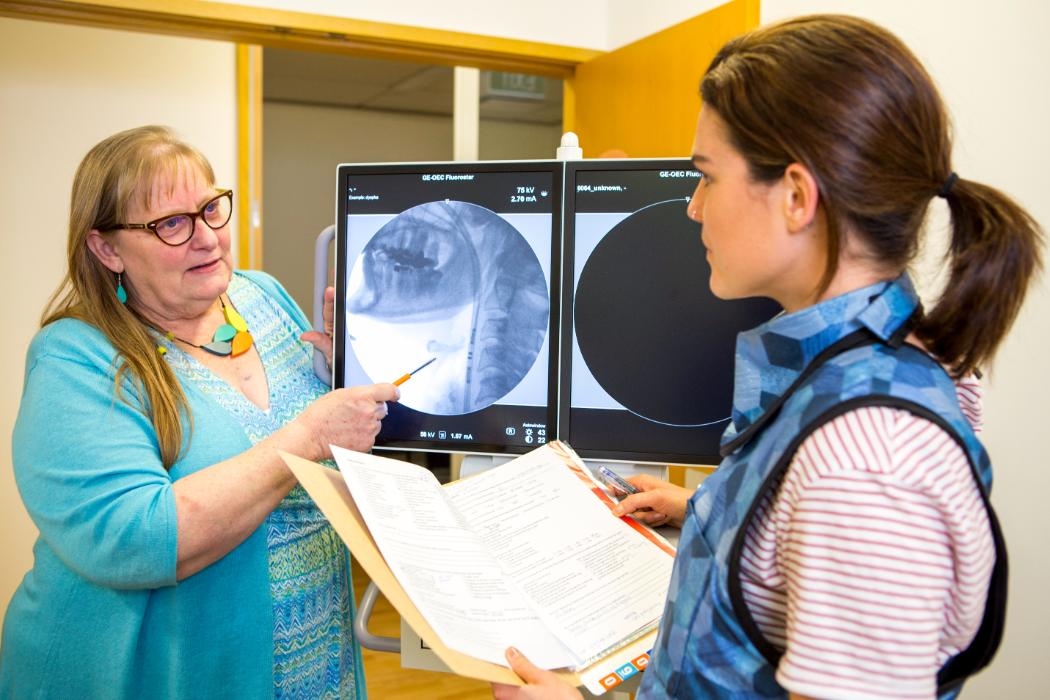Non-instrumental swallowing assessment and evaluation
Clinical swallowing evaluation – non-instrumental
This evaluation includes a detailed case history, an assessment of the motor and sensory function of the cranial nerves involved in swallowing, and an observational assessment of your eating and drinking. It provides the clinician with vital information that helps guide treatment recommendations and/or need for instrumental swallowing assessment.
Cough reflex testing
Cough reflex testing is part of the cranial nerve examination included in our non-instrumental clinical swallowing evaluation. It indicates if a person likely to be able to clear food or fluid from their airway.
Instrumental swallowing assessment and evaluation
Videofluoroscopic Swallowing Study (VFSS)
A Videofluoroscopic Swallowing Study (VFSS) is a moving x-ray of swallowing. It enables the speech-language therapist to assess the physiology of your swallowing, your swallowing safety, and guides management and treatment of your swallowing disorder. No special preparation is required prior to the procedure.
We are the only private clinic in New Zealand to offer VFSS. We have our own Fluorostar system on-site and our clinicians are trained in Radiation Safety and have a radiation use licence. In addition, Dr Anthony Lim is available as a consulting radiologist when required. A detailed diagnostic report is provided and if applicable treatment options discussed based on the findings of this assessment.
You can find more information about VFFS in this VFSS Information pamphlet.
Flexible Endoscopic Evaluation of Swallowing (FEES)
Videoendoscopic Endoscopic Evaluation of Swallowing (VEES) uses a flexible nasendoscope to assess swallowing. The nasendoscope is passed through your nose until the throat is in view. You are given food and drink, dyed with food colouring, to eat and drink whilst the nasendoscope is in place; this facilitates direct visualisation of your throat to enable assessment of your swallowing. VEES is unique, in that it also enables the assessment of how you manage your saliva. VEES can also be used to provide biofeedback as you participate in swallowing rehabilitation.
Low Resolution Pharyngeal Manometry (LRM)
Low Resolution Pharyngeal Manometry (LRM – pharyngeal) evaluates pressures in the throat when swallowing. There are 3 pressure sensors that measure the pressure at: 1. the level of the base of tongue to posterior pharyngeal wall approximation; 2. laryngeal additus, and 3. uppermost border of the cricopharyngeus muscle. This provides us with information about pharyngeal pressure timing and amplitude, and the co-ordination of swallowing pressures.
In addition to its role in evaluation, LRM- pharyngeal can provide visual biofeedback during rehabilitation. For example, it can provide visualization of the sequencing of swallowing pressures, and patients can train to re-sequence these pressures during swallowing with this unique biofeedback tool.
Other common diagnostic techniques, such as fluoroscopy and endoscopy, rely on a clinician’s subjective interpretation of moving images for diagnosis. Pharyngeal manometry, contrastingly, provides quantitative data that can be measured and compared in an objective manner.
Ultrasonography
Ultrasound uses high frequency sound pressure waves to visualise internal body structures and movements. Ultrasound offers many advantages compared to other imaging techniques as it is non-invasive, safe, relatively inexpensive, and portable, making it ideal for use in rehabilitative medicine. In swallowing rehabilitation, ultrasound can give clinicians information about the size of the muscles involved in swallowing (under the chin) as well as biomechanical changes during swallowing.
Communication assessment and evaluation
Acquired-language assessment
This evaluation includes a detailed case history, and at least two or more of the following: a cognitive screen; a standardized assessment of the 4 modalities of language (understanding spoken language, understanding written language (reading), verbal expression, and writing); psycholinguistic assessments; assessment of language in a functional context; and patient self-rated questionnaires, including a quality of life survey.
Acquired motor-speech assessment
This evaluation includes a detailed case history, evaluation of the underlying processes of speech (including respiration, phonation, resonance, articulation and prosody), speech intelligibility, and patient self-perception of their communication in everyday communication situations. These assessments may also be used as outcome measurements following a block of therapy.
Voice assessment
The Rose Centre clinics offer an SLT evaluation service for adults (16+) who are concerned about their voice, cough, or other laryngeal issues. We have state-of-the art diagnostic equipment that enables us to complete a thorough voice assessment. Voice evaluation may include:
- History of the voice problem or concern, current voice use and demands, and other issues that may affect vocal production
- Questionnaires completed by the client regarding perception of vocal handicap, quality of life related to voice, perception of symptoms
- Perceptual assessment of vocal quality
- Laryngeal Videostroboscopy using the Pentax Medical HD Laryngeal Stroboscopy system with rigid endoscope.
The evaluation takes 1 to 1 1/2 hours to complete. Depending on the results of the voice evaluation, we may recommend that you see an otolaryngologist/ENT surgeon for medical evaluation, if you haven’t already. We and/or the ENT may also recommend voice therapy as the next appropriate step.

